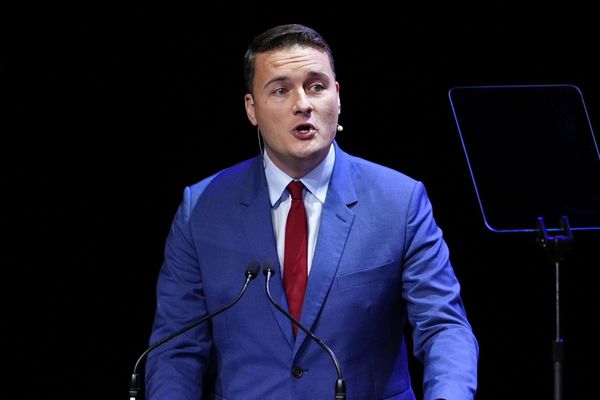The Federal Reserve hiked its key interest rate for the first time since 2018 on Wednesday and set the stage for an aggressive tightening of monetary policy to quell the biggest inflation outbreak in 40 years. Policymakers revealed their expectation for a total of seven quarter-point rate hikes this year and at least three more in 2023.
After the Fed meeting, the Dow Jones industrial average erased gains in afternoon stock market action, but found support and rallied strongly as Fed chief Jerome Powell answered questions. More constructive negotiations between Russia and Ukraine, and a massive stock rally in China also were in focus.
The Fed rate hikes penciled in as part of quarterly economic projections imply that the Fed's benchmark rate will go to a range of 1.75%-2% by the end of this year and at least 2.5%-2.75% in 2023. The latter figure implies policy will go beyond what Fed members consider to be the long-term neutral rate of 2.5%.
The Fed also was expected to settle on a plan to shrink its balance sheet, bloated by $4.5 trillion in crisis-driven purchases of Treasuries and government-backed mortgage securities since March 2020. As those bonds reach maturity, instead of reinvesting all the principal, the Fed will gradually let some of those assets run off the balance sheet. The policy statement indicated that Fed would begin to pare back asset holdings "at a coming meeting."
Shrinking the balance sheet "might be the equivalent of another rate increase," Powell said at his post-Fed meeting press conference.
The Fed policy statement noted that Russia's invasion of Ukraine and surrounding events "are likely to create additional upward pressure on inflation and weigh on economic activity."
Depiste that downside risk, the Fed still expects "solid growth," Powell said.
"All signs are that this is a strong economy, one that will be able to flourish in the face of less accommodative monetary policy."
Still, Powell's underlying message was at least potentially ominous. While expressing optimism that the labor market will remain strong as the Fed tightens, he added, "but we have to restore price stability." In other words, the Fed will get control of inflation, even if there is an economic price to pay.
Dow Jones Reaction To Federal Reserve Meeting
After release of the Fed meeting policy statement, the Dow Jones erased healthy gains but rallied as Powell spoke, running up 1.55%. The S&P 500 gained 2.2%. The Nasdaq composite leapt 3.8%, closing at session highs.
The takeaway from stock market action is that investors are endorsing the Fed's strategy. As long as it appears the Fed can get control of inflation without making policy overly tight, stocks may weather this storm.
Through Tuesday's session, the Dow Jones remained 8.85% below its record closed on Jan. 4, while the S&P 500 was 11.1% below its peak. The Nasdaq composite has fallen 19.4% from its Nov. 19 record close, as rising interest rates have taken a bigger toll on growth stock valuations.
Be sure to read IBD's daily The Big Picture column the get the latest on the underlying market trend and what it means for your trading decisions.
After the Fed policy news, the 10-year Treasury yield hit 2.24%, its highest level since May 2019 during the session, but eased back to 2.19% as Powell spoke.
Ahead of the Fed meeting decision, CME Group showed 75% odds of at least seven quarter-point rate hikes by December 2022.
Fed Is Way Behind The Curve
The Fed's rate hike comes almost two years to the day after it slashed its key policy rate close to zero amid the Covid lockdown. Yet just a year ago — despite the availability of vaccines and the just-passed $1.9-trillion stimulus, the Fed's March 2021 economic projections showed policymakers didn't foresee any rate hikes before 2024.
After a long period of quiescent inflation, the Fed had sworn off preemptive tightening. Until the central bank's full-employment mandate and 2% inflation target had been met, rate hikes would be off the table. In fact, the Fed went even further, insisting that inflation would have to exceed the target for some time before a rate hike.
Yet when inflation spiked last spring and summer, the Fed initially dismissed it as "transitory," due to short-run Covid-related supply constraints meeting a surge in demand as the economy reopened.
But inflation kept getting worse as the delta and omicron waves created more supply disruptions. Even as demand for workers surged, the variants also sapped labor force participation, through illness, early retirement and care-giving challenges. After years of struggling to reach 3%, wage growth shot up north of 5%, as workers demand pay-hikes that aren't eaten away by inflation, fueling still more price hikes.
Still, the Fed only gradually adjusted its plan. The Fed had committed to providing notice well in advance of scaling back asset purchases, which ran at $120 billion per month through October. Only once those purchases ended, as they did last month, would the Fed contemplate a rate hike.
So today's quarter-point hike in the federal funds rate target range to 0.25%-0.5% has left the Fed historically behind the curve. The policy rate is deeply negative in inflation-adjusted terms, with CPI inflation at 7.9% and the Fed's favored PCE inflation gauge at 6.1%.
Nimble Fed?
The main takeaway is that the Fed has its work cut out for it to shift monetary policy from being wildly accommodative to something close to neutral. That means policymakers will tighten with both fists — hiking the federal funds rate and shrinking the balance sheet. And they'll likely want to keep at it for a while, despite any modest softening of economic data.
Testifying to Congress on March 2, Powell sought to provide assurance that the Fed would be "nimble" in responding to the latest geopolitical curveball.
Some commentators have suggested that the Ukraine conflict could make the Federal Reserve more dovish. Jefferies chief financial economist Aneta Markowska disagreed.
"Powell can't afford to take his eyes off inflation, even in the face of geopolitical risks," she wrote after last week's February CPI report showed price pressures broadening out to the service sector.
QT's Impact On Stock Prices
If Deutsche Bank is right, the Fed could let $800 billion in assets run off its balance sheet this year. Another $1.1 trillion would follow next year. The impact of that $1.9 trillion in balance-sheet reduction might be like 3.5 rate hikes, Deutsche Bank says.
Fed asset purchases are widely seen as having a positive impact on stock prices. Fed buying of low-risk government securities holds down interest rates, encouraging risk-taking and underpinning stock valuations. The reverse process, dubbed quantitative tightening (QT), is therefore a headwind for the stock market. How big is, of course, hard to say.
The last time the Fed launched QT, in 2017, it went off without a hitch for the first year. But the stock market tanked in the fall of 2018, flirting with bear-market territory. Eventually, the Fed signaled retreat in early 2019, as rate hikes turned to rate cuts and QT gave way to more bond purchases.
"In dealing with balance sheet issues, we've learned that it's best to take a careful sort of methodical approach," Powell said at his Dec. 15 news conference. "Markets can be sensitive to it."
However, it was a pretty simple matter for the Fed to backpedal in early 2019 since inflation was tame. While the Fed may not want to rock the boat, it may not be able to offer a life raft.
Please follow Jed Graham on Twitter @IBD_JGraham for coverage of economic policy and financial markets.







